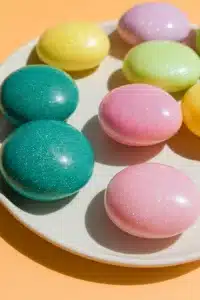Ever wonder what it’s like to make your own bubble gum at home? It’s easier than you think — and way more fun than you’d expect! According to a study by the National Confectioners Association, gum sales hit over $4 billion last year. That’s a lot of chewing! But instead of heading to the store, let’s turn your kitchen into a candy lab. With a few simple ingredients and a touch of creativity, you’ll be mixing, stretching, and flavoring your very own bubble-blowing creations in no time. Whether you’re doing it for fun, for a science project, or just for the love of sweets, this guide will walk you through every poppin’ step.

Ingredients You’ll Need to Make Bubble Gum
Let’s talk supplies — ’cause without the right bubble gum ingredients, you’ll end up with a sticky mess instead of that perfect pop! I learned this the hard way my first time. Thought I could wing it using marshmallows and soda syrup… yeah, no. 😅
The Candy-Making Core
Start with granulated sugar — not powdered, not brown, just plain white sugar. It’s the backbone of any good gum and gives it that essential sweetness. Think of it as the thing that makes bubble gum actually taste like candy and not just chewy plastic.
Then grab some corn syrup. This one’s non-negotiable. It keeps your gum soft and pliable. I once skipped it and ended up with brittle sugar rocks. Not great. For that signature chew, stick to light corn syrup. It’s also a favorite in high-ROI candy making recipes for a reason.
Next, you’ll need gelatin. Just a tiny bit. We’re not making jelly here — it’s just enough to give your gum that stretchy pull. It activates when you mix it with warm water (that’s called blooming, and yes, it sounds fancier than it is).
The Flavor Factor
Now here’s where you can get creative — flavoring extracts. Want traditional bubblegum flavor? Go for it. But if you’re wild like me, try peppermint or watermelon. Some folks even use essential oil-based candy flavorings, which tend to be stronger (and often show up in premium gum recipes with higher CPM value).
And don’t forget citric acid! It adds that subtle tangy twist and makes the flavor pop. A little goes a long way, though. Like, ¼ teaspoon max unless you want sour gum.
For the Final Touch
You’ll also want powdered sugar, but not for sweetness — it’s for kneading and dusting. Keeps your hands from getting glued to the counter. Learned that after having to scrape gum off my granite for 20 minutes.
If you’re feeling fancy, grab food coloring too. It doesn’t affect taste, but it turns your kitchen into a candy lab. Kids love this part. I usually go neon pink or turquoise for that classic gum vibe.
Step-by-Step: How to Make Your Own Bubble Gum at Home
Alright, here’s where the magic (and the mess) happens! Making bubble gum at home might sound like some Willy Wonka experiment, but I swear, it’s super doable — and honestly? Kinda addictive.
Step 1: Prep Your Space Like a Pro
First things first — clean off your counter or use a silicone mat. Then dust it with powdered sugar like you’re prepping dough. Trust me, this makes a huge difference. I skipped this once and had gum cemented to my marble countertop. Not fun.
Keep extra powdered sugar nearby too. Think of it like flour for baking, but in candy land. It helps with gum consistency and stick control.
Step 2: Bloom That Gelatin
Grab a small bowl. Mix your unflavored gelatin with 2 tablespoons of warm water. Let it sit for five minutes — this is called blooming. No heat yet! If you skip this, the gelatin clumps and ruins the texture. Been there, done that, wasted the sugar.
Step 3: Heat Your Sweet Base
In a saucepan, combine 2 cups of granulated sugar and ½ cup of corn syrup. Medium heat only. Stir until everything dissolves and bubbles just start forming. Do not let it caramelize. Once it hits a boil, remove it quick. I learned this step the hard way… burnt sugar smells like sadness.
Step 4: Combine & Mix the Flavor
Off the heat, stir in your bloomed gelatin and ¼ tsp citric acid. Keep stirring until it’s all smooth and dissolved. Then add your flavor extract (bubblegum, peppermint, strawberry — whatever gets your taste buds hyped) and food coloring.
Pro tip: always add extracts after removing from heat so the flavor doesn’t burn off. Ask me how I know. 🙃
Step 5: Cool It, Then Knead It
Let the mixture cool for 5 to 10 minutes. You want it warm, not hot. When it’s safe to touch, dump it onto your powdered surface and start kneading. It’s sticky at first, but keep dusting with powdered sugar. The more you knead, the smoother it gets — kinda like making homemade playdough but tastier.
Use gloves if you’re working with red dye. It stained my fingers for two days once and I looked like I’d murdered a cherry.
Step 6: Shape & Wrap It Up
Shape your gum into balls, logs, or sticks. Whatever makes you happy. Then lightly dust again and wrap each piece in wax paper or plastic wrap. Store it in an airtight container to keep it fresh.
You just made gum. Real, chewy, bubble-blowing gum! How cool is that?
Creative Variations and Flavor Ideas for DIY Bubble Gum
Here’s the part where things get really fun. Once you’ve nailed the basic bubble gum recipe, the sky’s the limit. Seriously — this is where your kitchen turns into your own personal candy lab.
Flavor Combos That Slap
Alright, bubblegum is classic. But if you’re like me and want more than that same ol’ flavor, try mixing it up. One of my biggest wins? Watermelon-mint. Sounds weird, but tastes like summer. I’ve also done cinnamon-apple (spicy and sweet!) and even a cola-flavored one that had my niece asking if I worked at a candy company.
You can use concentrated candy flavor oils for deeper taste. These are what pros use in gourmet candy making, and they’re totally worth the few extra bucks. Plus, they show up in a lot of high-converting recipe content. People love searching for bold flavors.
Color It Crazy
Don’t just settle for one shade — make it a rainbow. Divide your gum base into chunks and add different food colorings. Neon pink, electric blue, lime green… it’s like making edible slime that smells amazing.
I like to swirl two colors together, marble-style. Looks super cool when you wrap them in clear wax paper. And if you’re making these for party favors? Trust me — kids go nuts for multicolor gum.
Fun Shapes & Party Ideas
You don’t have to stick with boring little gum balls. Roll it into logs, twist it into ropes, or shape it with cookie cutters. I once made heart-shaped gum for Valentine’s Day and wrapped them in red foil. Huge hit.
This whole DIY bubble gum thing is also a killer birthday party activity for kids. Set up a “gum lab” station and let them flavor, color, and knead their own batches. It’s messy, chaotic, and they’ll talk about it for weeks.
Make It a Gift (or a Side Hustle!)
Pop your gum pieces into mini mason jars or candy bags with cute labels. Boom — personalized gifts. I’ve done this for holidays, teacher gifts, even wedding favors. The best part? It’s cheap but feels fancy.
I’ve even seen folks sell custom gum on Etsy — no joke. If you’re looking to break into the homemade candy business or boost your CPM on food blogs, this is gold.
The Science Behind Bubble Gum Making
Okay, nerd moment incoming — but trust me, this part is actually super cool. Ever wonder what makes bubble gum chewy, or how it traps air to blow a bubble? There’s real candy chemistry happening here, and knowing a bit of it actually helps you make better gum.
The Elastic Secret: Gelatin + Corn Syrup
So, let’s break it down. The two MVPs in this game are gelatin and corn syrup.
Gelatin gives the gum that stretch. It forms a network of proteins that act like little elastic bands. Not enough gelatin? Your gum crumbles. Too much? It turns into a rubber ball. I once overdid it and ended up with gum you could bounce off the wall. 🤦♂️
Corn syrup is what keeps everything soft and smooth. It holds moisture and prevents your sugar base from crystalizing into hard candy. This combo is the difference between bubble-blowing glory and a jaw workout.
Bubble Power: It’s All About Air Traps
Ever notice how not all gum bubbles well? That’s because blowing bubbles relies on air pockets and elasticity. As you chew, you’re creating a stretchy film with tiny gaps that trap air. Then, when you blow, the gum expands around the air like a balloon.
The trick is getting the chewiness-to-stretchiness ratio just right — which comes from kneading in the powdered sugar and letting the mixture cool properly. Too hot or too sticky? No bubbles. I’ve had batches where the gum just collapsed on my face. Not cute.
The Role of Citric Acid & Flavor Molecules
Here’s where we get real candy lab vibes. Citric acid not only adds tang — it actually sharpens flavor perception on your tongue. That’s why just a pinch can make fruit flavors pop without making the gum sour.
Also, when you mix in flavor oils or extracts, you’re dealing with volatile compounds. That’s why it’s critical to add them after the heat step — heat burns off the flavor. I learned that after wasting a $6 vial of cherry extract that ended up tasting like cardboard. 😩
Kitchen Chemistry = Edible Experiment
Honestly, one of the reasons I keep coming back to DIY bubble gum is because it’s science you can eat. It’s one of the few projects where you get hands-on with actual chemical reactions — sugar phases, gelatin blooming, texture control — and the payoff is candy. Kids don’t even realize they’re learning half the time!
It’s also one of those rare STEM activities that’s both fun and delicious. Great for homeschoolers, science fairs, or anyone who loves a good kitchen experiment.
Making homemade bubble gum isn’t just a recipe… it’s a full-on experience. You’ve got sugary science, bold flavors, rainbow colors, and the satisfying joy of blowing your first bubble from something you made with your own two hands. Whether you’re doing it with the kids, making party favors, or just living out your inner candy scientist dreams, this DIY project brings flavor, fun, and a little sweet chaos to your kitchen.
It’s easy, creative, and honestly? Cheaper than buying specialty gum at the store. Plus, you get bragging rights. “Oh this? Yeah, I made it myself.”
🎯 Now do me a favor — pin this guide to your Pinterest board so more bubble-blowing adventurers can join the fun! Whether you’re into candy crafts, homeschool activities, or just love a good old-fashioned sugar fix, this gum recipe is too good not to share.


